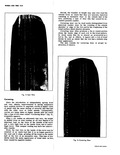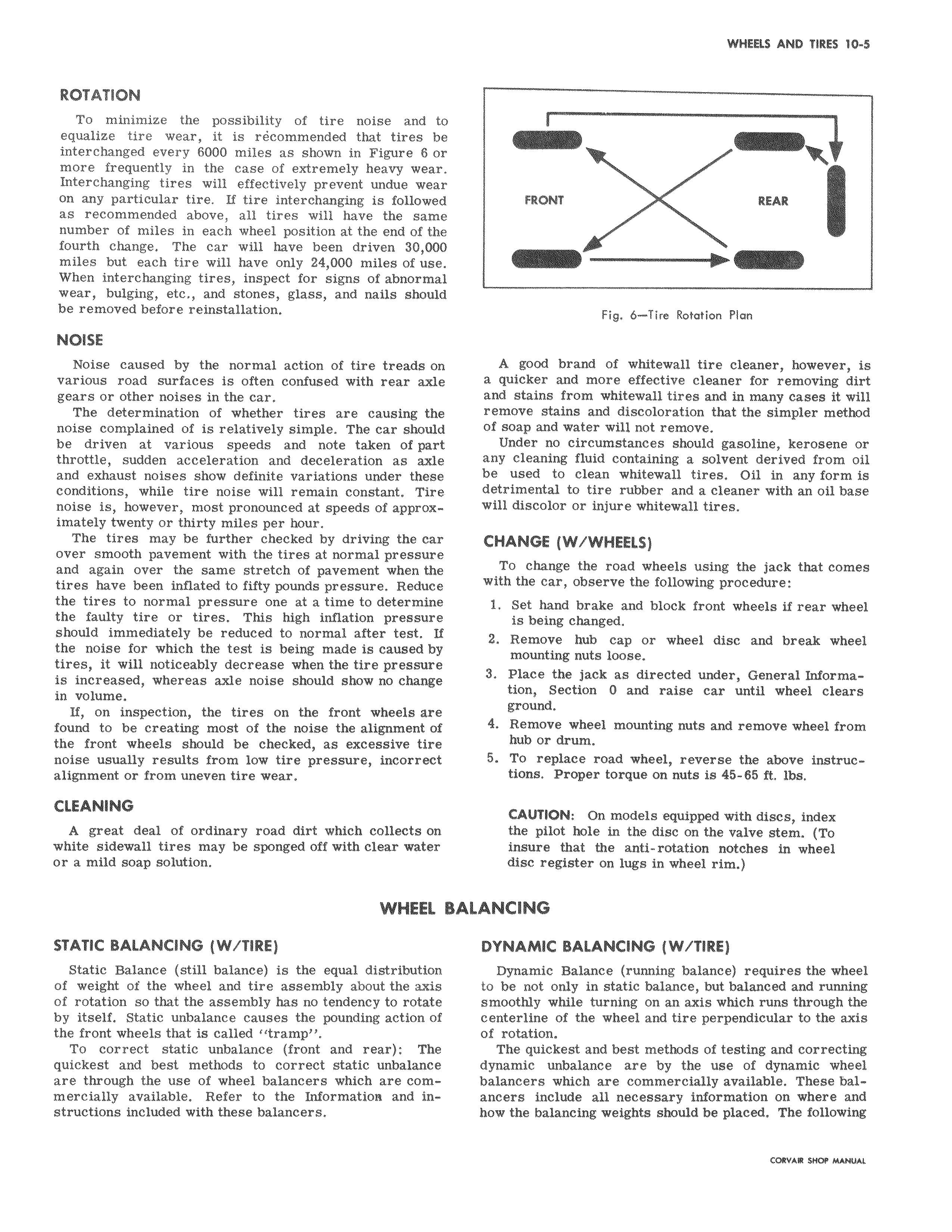Jeep Parts Wiki | Ford Parts Wiki
Home | Search | Browse
|
Corvair Chassis Shop Manual December 1964 |
|
Prev

 Next
Next
ROTATION To minimize the possibility of tire noise and to equalize tire wear it is recommended that tires be interchanged every 6000 miles as shown in Figure 6 or more frequently in the case of extremely heavy wear Interchanging tires will effectively prevent undue wear on any particular tire If tire interchanging is followed as recommended above all tires will have the same number of miles in each wheel position at the end of the fourth change The car will have been driven 30 000 miles but each tire will have only 24 000 miles of use When interchanging tires inspect for signs of abnormal wear bulging etc and stones glass and nails should be removed before reinstallation NOISE Noise caused by the normal action of tire treads on various road surfaces is often confused with rear axle gears or other noises in the car The determination of whether tires are causing the noise complained of is relatively simple The car should be driven at various speeds and note taken of part throttle sudden acceleration and deceleration as axle and exhaust noises show definite variations under these conditions while tire noise will remain constant Tire noise is however most pronounced at speeds of approximately twenty or thirty miles per hour The tires may be further checked by driving the car over smooth pavement with the tires at normal pressure and again over the same stretch of pavement when the tires have been inflated to fifty pounds pressure Reduce the tires to normal pressure one at a time to determine the faulty tire or tires This high inflation pressure should immediately be reduced to normal after test If the noise for which the test is being made is caused by tires it will noticeably decrease when the tire pressure is increased whereas axle noise should show no change in volume If on inspection the tires on the front wheels are found to be creating most of the noise the alignment of the front wheels should be checked as excessive tire noise usually results from low tire pressure incorrect alignment or from uneven tire wear CLEANING A great deal of ordinary road dirt which collects on white sidewall tires may be sponged off with clear water or a mild soap solution WHEEL 8 STATIC BALANCING W TIRE Static Balance still balance is the equal distribution of weight of the wheel and tire assembly about the axis of rotation so that the assembly has no tendency to rotate by itself Static unbalance causes the pounding action of the front wheels that is called tramp To correct static unbalance front and rear The quickest and best methods to correct static unbalance are through the use of wheel balancers which are commercially available Refer to the Information and instructions included with these balancers r FRONT X REAR Fig 6 Tire Rotation Plan A good brand of whitewall tire cleaner however is a quicker and more effective cleaner for removing dirt and stains from whitewall tires and in many cases it will remove stains and discoloration that the simpler method of soap and water will not remove Under no circumstances should gasoline kerosene or any cleaning fluid containing a solvent derived from oil be used to clean whitewall tires Oil in any form is detrimental to tire rubber and a cleaner with an oil base will discolor or injure whitewall tires CHANGE W WHEELS To change the road wheels using the jack that comes with the car observe the following procedure 1 Set hand brake and block front wheels if rear wheel is being changed 2 Remove hub cap or wheel disc and break wheel mounting nuts loose 3 Place the jack as directed under General Information Section 0 and raise car until wheel clears ground 4 Remove wheel mounting nuts and remove wheel from hub or drum 5 To replace road wheel reverse the above instructions Proper torque on nuts is 45 85 ft lbs CAUTION On models equipped with discs index the pilot hole in the disc on the valve stem To insure that the anti rotation notches in wheel disc register on lugs in wheel rim ALANCING DYNAMIC BALANCING W TIRE Dynamic Balance running balance requires the wheel to be not only in static balance but balanced and running smoothly while turning on an axis which runs through the centerline of the wheel and tire perpendicular to the axis of rotation The quickest and best methods of testing and correcting dynamic unbalance are by the use of dynamic wheel balancers which are commercially available These balancers include all necessary information on where and how the balancing weights should be placed The following CORVAR SIWP MANUAL

 Next
Next